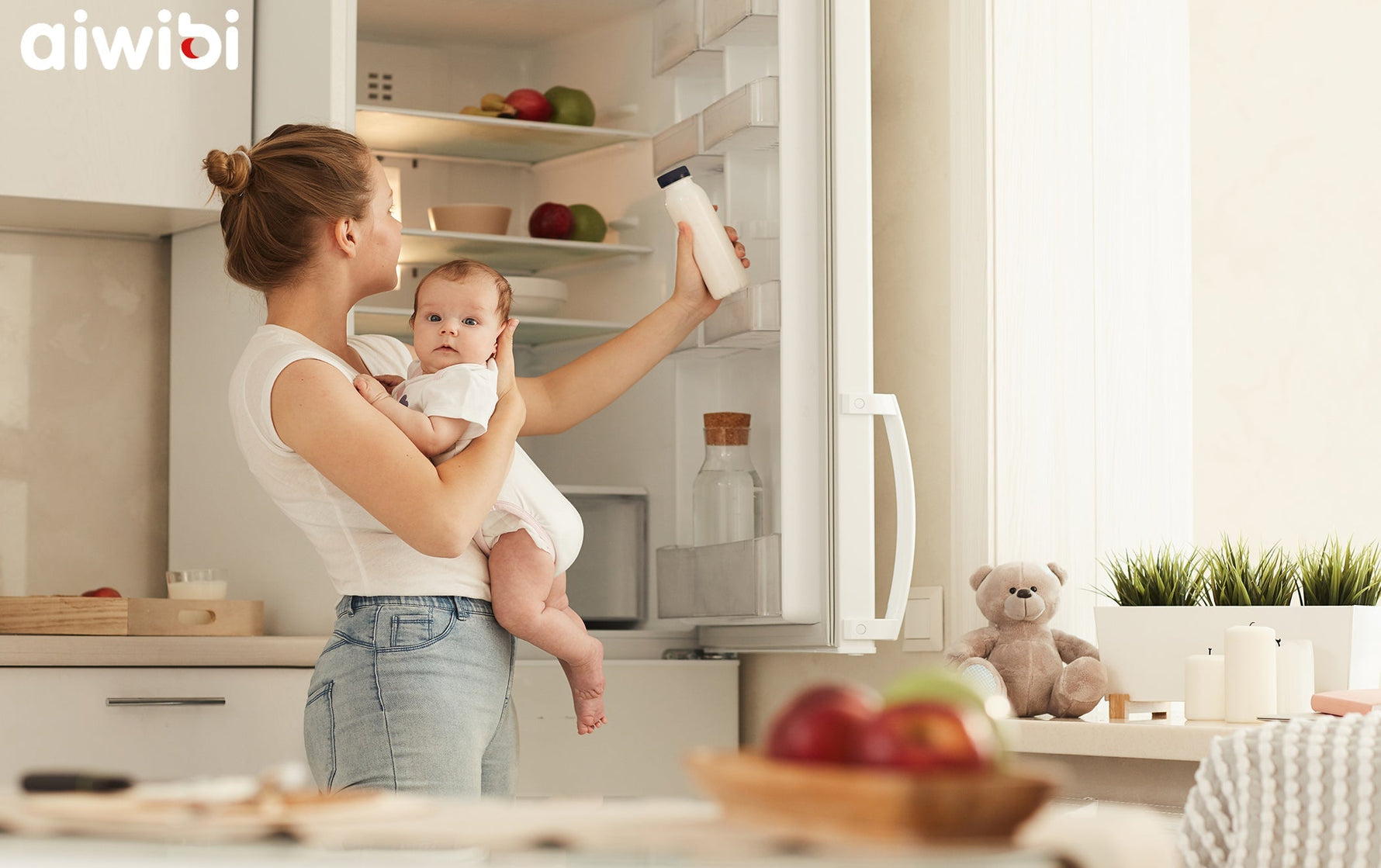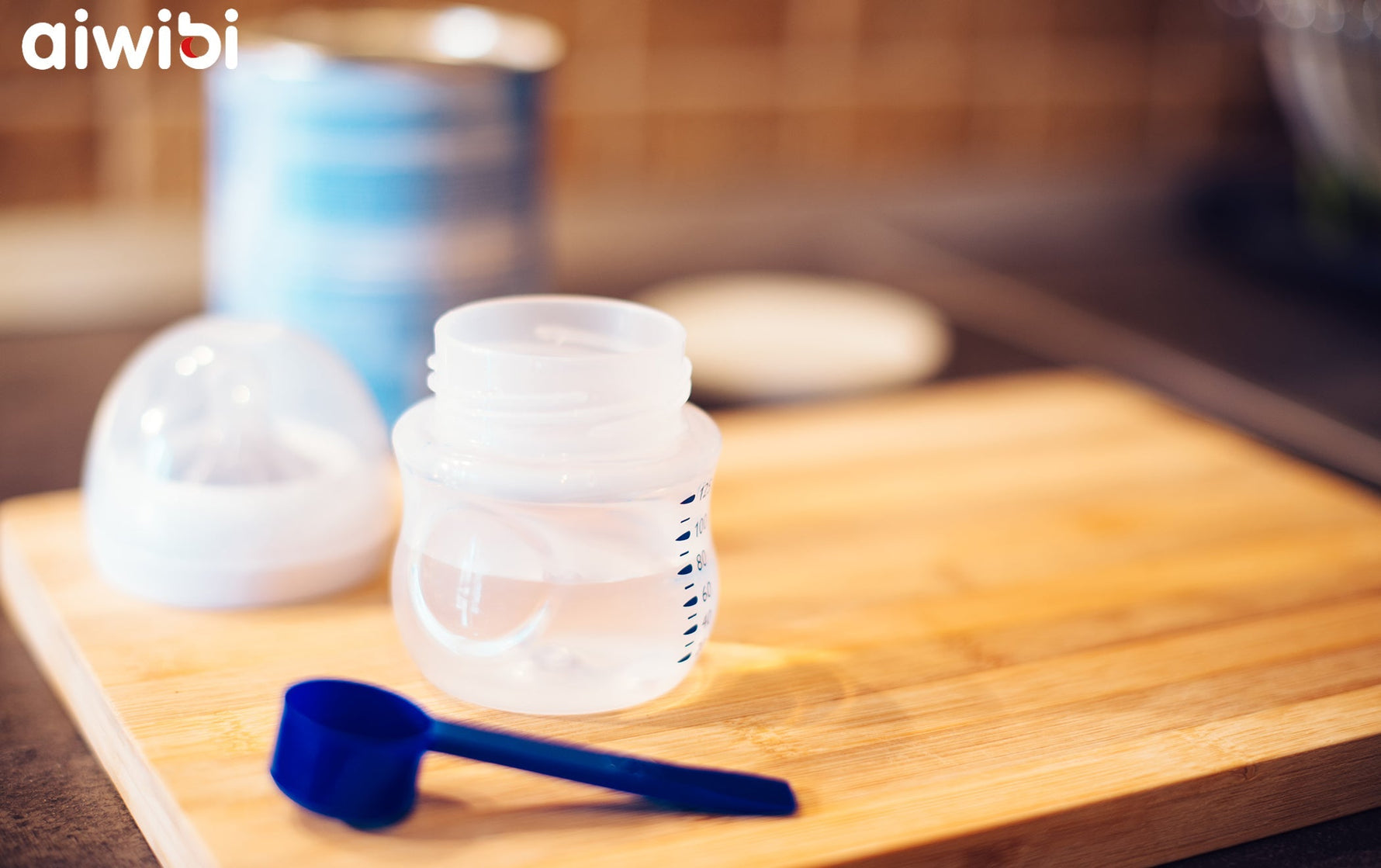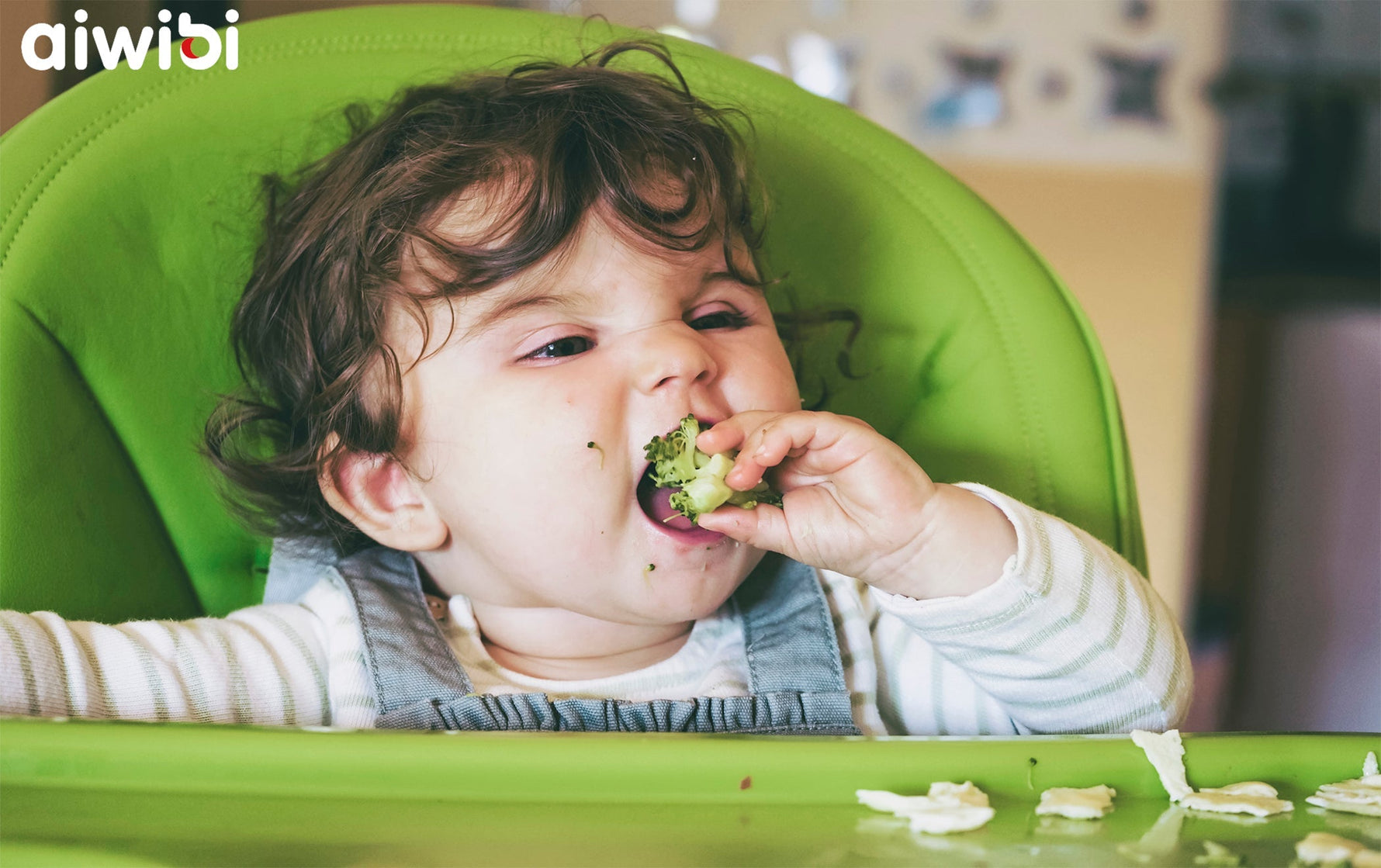Bài Viết

There are two reasons why a baby may become constipated.
1.The structure of complementary food is not reasonable, and the structure of complementary food with more meat and less vegetables will easily cause insufficient intake of dietary fibre and cause constipation.
2.Constipation is a sign of allergy and there may be foods in the complementary diet that are causing your baby's allergy and the allergens need to be identified.
If allergens are detected in complementary foods, a "dietary avoidance" is required. Parents should ensure that their baby's complementary foods do not contain allergenic foods and that the baby's diet is balanced to ensure normal growth.
If no allergens are detected in complementary foods, constipation in babies can be improved as follows:
A balanced diet
In addition to ensuring a daily milk intake, parents should pay attention to a balanced diet, especially with adequate intake of vegetables and fruits, and a good mix of meat and vegetables. Dietary fibre (e.g. prebiotics) can also be supplemented to promote the growth of beneficial bacteria in the baby's intestinal tract to protect it from constipation caused by intestinal dysfunction.
Increase water intake
Some babies are constipated because they drink too little water. These babies' poops are usually dry, hard and dark, or even as bad as sheep faeces, and they struggle to pass poop. In such cases, mothers are advised to increase the amount of water their babies drink, and to drink warm water as appropriate.
Let the baby exercise more
The less your baby moves, the greater the risk of constipation. Make sure your baby crawls, rolls back and forth or walks a lot during the day, as more movement helps with bowel movements. If your baby is too young, parents can try gently giving your baby leg exercises by pushing his or her knees alternately into the abdomen. This helps to move food through the digestive system, making the digestive tract move better and helping with bowel movements.

Although how much a formula-fed baby eats at each meal can be known by the scale, each baby is an individual and feeding infant formula can be too much or too little. If you want to tell whether your baby is drinking enough or not, you can tell from your baby's mental state and drinking status, but also from the following 3 aspects.
1.Does green poop appear due to hunger
If your baby always has green poop, mothers should pay attention to whether it is a type of green poop. Your baby's digestion is normal, the intestines keep moving normally and digestive juices are secreted normally. The unused digestive juices, especially bilirubin, are green when passed in the stool. The stools may be more frequent, with mucus in them, and similar in shape to the green poop caused by cold, but the volume of the stool is relatively less.
2.Observe the condition of your baby's skin A baby's skin is smooth and full in its normal state. If your baby drinks enough milk daily and ensures a good nutritional intake, then your baby will present a better skin condition. If you do not drink enough milk, resulting in insufficient intake of protein and fat, this will affect the condition of your baby's skin, such as the appearance of wrinkles.
3.Does your baby cry continuously
Babies who are hungry cry very easily. So if your baby is crying more than usual, it may be due to a lack of milk, but it is important not to "feed by crying", but to judge how often your baby feeds. If your baby is hungry and cries quickly and starts to gurgle when you get a bottle, then it is a sign that your baby has not had enough milk at the last feeding and needs to be fed more.

Types of childhood eczema
· Atopic dermatitis
Frequently, children with atopic dermatitis also have asthma and hay fever, a combination sometimes known as the “atopic triad.” The rash from atopic dermatitis can be lighter or darker than normal skin color, and it often forms at the creases of elbows and knees.
· Contact dermatitis
As the name implies, contact dermatitis results when a substance touches your child’s skin. There are two subtypes. Allergic contact dermatitis triggers an immune system response, while irritant contact dermatitis immediately affects the skin. A rash from contact dermatitis may produce itchy bumps called hives, and skin in the area can become thick and scaly.
· Seborrheic dermatitis
Also known as “cradle cap,” seborrheic dermatitis affects areas of the skin with lots of sebaceous glands that produce the skin oils that provide a protective layer on the skin. The back, nose, and scalp are the most commonly affected areas, but it can also form lower on the face, in the diaper area, and in various folds around a baby’s body. Skin rashes include a yellow crust along with red skin, or there may be white or yellow flakes. Cradle cap usually vanishes around the age of six months, but dandruff might continue even into adulthood.
· Dyshidrotic eczema
Blisters on the soles of the feet and palms of the hands identify dyshidrotic eczema. These blisters can be itchy, and large blisters occasionally form, which are often more painful. After the blisters pass, affected skin can feel dry and spongy. This skin condition seems to be connected to seasonal allergies. Children can develop this type of eczema, but it’s usually more common in adults, with women affected more often than men.
Causes of baby eczema
Skin is not moisturized enough: baby's skin stratum corneum is weak, the skin barrier function is not yet developed, can not lock moisture, if not enough moisturizing is easy to trigger eczema, to apply baby cream in time.
Eczema from wearing too much:Overdressing your baby can cause symptoms such as redness, pimples and itching. Try to avoid dressing your child in thick clothing and dress your child appropriately for the weather.
Other factors:Eczema is easily triggered when external irritants such as dust, pollen, smoke, mites and sweat come into contact with your baby's delicate skin, or when new toys and clothes carry bacteria that make your baby's skin irritated.
How to treat baby's eczema
Daily bathing and moisturizing is key to treating baby (infantile) eczema (atopic dermatitis). Use a mild cleanser and warm water. After a bath of no more than 15 minutes, rinse completely, gently pat your baby dry and apply a fragrance-free cream or ointment such as petroleum jelly, while the skin is still damp. Moisturize at least twice a day, perhaps at diaper changes. When trying a new moisturizer, test it on a small area of the child's skin first to make sure it's well-tolerated.
Baby eczema signs and symptoms may also be eased by avoiding irritants — such as itchy fabric and harsh soaps — as well as extremes in temperature. To prevent your child's scratching the rash, it may help to keep your baby's nails clipped short or to put on cotton mittens during sleep.
Have your baby examined if the condition persists or the rash is purple, crusty and weepy or has blisters. A child who has a fever and rash may also need evaluation. Talk with your doctor about using a medicated cream or ointment or trying bleach baths to ease symptoms. Use medications and bleach baths with the guidance of your pediatrician.

Growth is an essential aspect of every child's life. As parents, we want our children to grow healthy and strong. Here are three major helpers for children's growth:
1.Good Sleep
Getting enough sleep is crucial for children's growth. Here are some tips for ensuring your child has a good night's sleep:
·It is recommended to go to bedbefore 9:00 pm and wake up at 6:30 am
·Allow your child to have their own bed and room after the age of three
·Keep the sleeping environment dark, and avoid using night lights
Tip:The peak time for growth hormone secretion is around 10:00 pm. Therefore, it is recommended that children go to bed around 9:00 pm and enter deep sleep by 10:00 pm.
2.Proper Exercise
Regular exercise is necessary for children's growth.Here are some tips for ensuring your child gets enough exercise:
·Exercise in the morning before meals or half an hour to an hour after meals
·Avoid high-intensity exercise, especially for children and teenagers
·Follow the standard of low-intensity, long-duration, and uninterrupted exercise
Tip:Keep a happy mood during exercise, wear appropriate shoes, and avoid hindering bone growth and development.
3.Balanced Diet
A balanced diet is essential for children's growth. Here are some tips for ensuring your child gets the right nutrients:
·Protein is the foundation of life and should not be overlooked
·Minerals, such ascalcium and iron, are crucial for bone development
·Fatty acids should be supplemented in moderation, and natural sources are preferred
Tip:If your child is a picky eater, consider adding infant nutritional supplements to promote their growth. Some common foods that promote growth include tofu, milk, spinach, shrimp, nuts, and sesame.
In conclusion,good sleep, proper exercise, and a balanced dietare the three major helpers for children's growth. As parents, we need to pay attention to these three aspects to ensure our children grow healthy and strong.

As parents, it's essential to pay close attention to your baby's health and nutritional needs. Here are five signs that indicate it may be time to change your baby's formula:
1. Your baby has suddenly stopped drinking milk, and their consumption has significantly decreased. If your baby doesn't like the taste of the formula or is lactose intolerant, it can lead to a decrease in milk consumption. Be sure to observe whether there is a strange taste in the formula and consider switching to a different formula that suits your baby's needs.
2. Your baby's height and weight are not up to standard compared to other babies of the same age. While genetics and other factors may play a role, it's important to consider whether your baby's formula provides adequate nutrition. Short-term malnutrition caused by formula milk can have a significant impact on your baby's growth and development.
3. If your baby experiences diarrhea three to five times a day or more after consuming formula milk, it could be a sign of lactose intolerance. To address this issue, parents should consider promptly switching to a low-lactose formula or seeking medical help. In this case, parental attention and timely response are crucial.
4. When a baby experiences prolonged bowel movements or constipation, such as starting to have stools after more than three days and having dry and hard stool, it is important to consider whether the constipation is caused by drinking formula or the baby's poor digestion and absorption of the fatty ingredients in the formula.
5.Dry heaving and vomiting for no apparent reasoncan be a sign of excessive air inhalation during feeding, food accumulation in the baby, an underdeveloped sphincter, or formula allergy. If you suspect an allergy, look for signs of diarrhea, which typically accompany formula allergies.
Remember, every baby is unique, and it's essential to detect and resolve any potential nutritional or health issues early on. If you notice any of these signs, it's crucial to consult with a medical professional and consider switching to a different formula that meets your baby's needs.

0-6 months
According to the World Health Organization, breast milk already provides adequate dietary calcium for infants, and the calcium content of formula is based on breast milk as a reference, so there is no need to be concerned about calcium deficiency in babies who drink breast milk normally from 0-6 months of age.
Premature babies are unique, and the American Academy of Pediatrics recommends calcium and phosphorus supplements, as well as special supplements designed for premature babies, in addition to vitamin D supplements.
7-12 months
The calcium intake recommendation for babies this age is 250 mg per day, a slight increase from 0-6 months.
The American Academy of Pediatrics recommends that babies at this age be fed primarily breast milk or formula, with a reasonable mix of cereals, vegetables, meat, yogurt, juice, and other supplements.
Calcium is found in yogurt and low-oxalate cabbage, broccoli, and kale, and these foods can easily meet the calcium intake target.
Over 1 year old
You should make sure your child's milk intake is 400-600mL per day for children aged 1-3 years old and 300-600mL per day for children aged 3 and up. Then focus on eating tofu, eggs, vegetables, meat, and so on.
Some parents may find it difficult to calculate their child's daily diet: how much of this to consume, and whether that consumption is sufficient. They believe that taking calcium supplements directly is preferable.
However, a well-matched diet for your child will provide not only calcium but also other nutrients that promote your child's development and good habits of a balanced diet.

In the wake of devastating earthquakes that struck Turkey and Syria, people from all walks of life came forward to donate generously towards helping the affected children. These donations have allowed aiwibi to come together to be able to provide clean and hygienic diaper products to children in need, and a total of 543 boxes with a market value of Dh224,802 were donated during the campaign. Doing our best to send a little help to the children in the disaster area.
The earthquakes, which occurred in the region in recent weeks, caused widespread damage and destruction, leaving many children and their families in urgent need of assistance. In response, aiwibi launched a campaign to assist the affected children. Aiwibi authorizes the aiwibi Dubai branch to conduct relief material transfer operations. As a result, for any orders received by www.aiwibi.ae for donation to the victims of Turkey and Syria, Aiwibi will donate the same quantity ordered by the donators, either under the name of the donators or Aiwibi, which means that if you order 5 packs, Aiwibi will deliver 10 packs to the Emirates Crescent, then send relief supplies to the earthquake area through their help.
The response to aiwibi's donation campaign was overwhelming, from small contributions to large donations, every bit of support has made a significant difference in the lives of those affected.
We are extremely grateful to everyone who has donated towards our relief efforts in Turkey and Syria. Your generosity and kindness have made a real difference in the lives of children who have been affected by these earthquakes. Your donations have helped us provide them with the essentials they need to survive and rebuild their lives. Aiwibi will continue to work tirelessly to support those affected by the earthquakes.
The outpouring of support towards aiwibi's relief efforts in Turkey and Syria is a testament to the compassion and generosity of people from all walks of life. In these difficult times, it is heartening to see people come together to support those in need, and aiwibi is grateful to be part of this collective effort to make a positive difference in the world.
We extend our sincerest thanks to all those who generously contributed to the relief efforts for the victims of the earthquake.

Taboo 1: Formula and medicine taken together
When the baby is sick, the baby does not want to take medicine, so parents come up with a good way, that is, let the baby drink formula together with the medicine.
But formula will directly reduce the medicinal properties, thus affecting the recovery of the baby's condition. It is best to take medicine with warm water, do not use formula, honey water, and other water instead of warm water.
Taboo 2: Formula change too often
Some mothers change formula because they see that their babies are not growing or their stools are green, not knowing that changing formula can have a great impact on the baby.Changing the formula in the early stages will make the intake reduced, triggering indigestion, and sometimes causing vomiting, diarrhea, constipation, and other symptoms.It is also important to avoid the practice of changing formulas just because some mothers have heard that a certain formula is good. In addition to changing formulas, because your baby is allergic to a particular one, the most important thing is to stick to feeding the same formulas.
Taboo 3: Mixing several formulas for a long time
Parents are overly concerned about the safety of formulas or focus too much on the concept of nutritional complementarity, lack trust in a single formula, are afraid to insist on eating the same brand of formulas, worried that in case the formulas have quality problems, the baby is vulnerable. They think that if they eat several formulas at the same time, it is less likely that there will be problems with quality, so they give their babies several formulas at the same time, thinking that this will share the risk and is good for them. However, different formulas have slightly different nutritional compositions, protein, fat structure, mineral content, etc. There is an adaptation period for the baby's intestines, and mixing several formulas is not good for the baby's intestinal development and digestion, especially when the baby is small and the intestines are more fragile.
If parents are not sure about the formula for babies, it is recommended to choose a reliable brand with a high reputation, and then consider switching to another formula after five or six months of consumption.

Change number one: eat more staple foods.
After the child is one year old, staple food and vegetables are the main meals, so give your child three meals a day of staple food and vegetables, and just make sure 400-600ml of milk is consumed every day, and eat staple food and vegetables the rest of the time.Try to vary the child's daily diet because different foods can provide different nutrition!
Change number two: add a small amount of salt to your child's food.
After the first year, parents can add a pinch of salt to their child's food. If the child can eat food without salt, you can skip the salt for a while.
Because natural food contains a lot of sodium, it is especially important for children to eat some seafood, such as oysters, nori, and seaweed.
Change number three: allow children to learn to eat on their own.
Children must eat independently. Children learn to eat on their own so that they can know how much they need to eat at each meal, to avoid children eating too much or not enough, resulting in malnutrition, and to avoid picky anorexia in children!
Allow your child to eat on his or her own and don't be concerned about him or her getting dirty. In exchange for the child soiled clothes, the child will eat by themselves, as well as exercise the child's fine motor skills and aid in the child's brain development.

